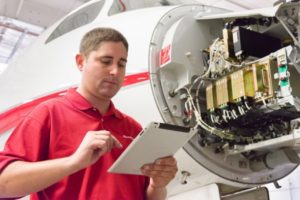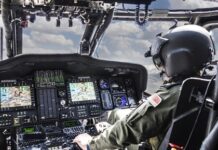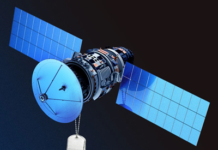
APEX Insight: With Honeywell Aerospace’s flagship connectivity hardware product now live, the technology and manufacturing company is eager to demonstrate the promise of its connected aircraft solutions portfolio.
Twenty-seventeen promises to be a banner year for Honeywell Aerospace and its marquis product JetWave. After receiving its final certification and going live with Inmarsat GX Aviation in-flight Wi-Fi late last year, in January the connectivity hardware made its debut in the commercial airline market and is now connecting passengers on select Lufthansa Group flights. With 500 JetWave deliveries to date and up to 1,000 more in progress, mechanics and engineers will have no shortage of work to do.
But the same holds true for the software engineers and data crunchers. “The aerospace industry is going through a monumental shift right now,” says Kristin Slyker, vice-president, Connected Aircraft, Honeywell Aerospace. “Access to high-speed connectivity brought a revolution for passengers and their experience on a plane, but that’s just the tip of the iceberg.” Since the airline business case for passenger Wi-Fi offers negligible returns, mining that iceberg for additional value in the connectivity investment will become increasingly important.
“The aerospace industry is going through a monumental shift right now.” — Kristin Slyker, Honeywell Aerospace.
Ultimately what the iceberg amounts to is data. Aircraft can generate terabytes of data in a given day, but most of it stays on the airplane. “Now that the aerospace industry has access to a high-bandwidth data pipe, we have a new ability to pull this critically important data from the plane and create data from,” explains Philip Hermann, director of Product Marketing, Connected Aircraft for Honeywell.
Along these lines, Honeywell’s beyond-the-cabin connectivity portfolio is diverse. With real-time weather data being pushed to its GoDirect Weather Information Service, pilots can make more informed decisions while improving fuel and flight efficiency – saving airline an estimated $25,000–$100,000 per aircraft annually. Go Direct Fuel efficiency collects data from and airline’s fleet operations and can recommend, for instance, the precise time to deploy wheels to land safely so no unnecessary drag is created and not a drop of fuel is needlessly lost.
In a more creative approach, the company is preparing to deploy an update that will crowdsource weather data from aircraft using its RDR400 radar system. “If you have enough aircraft in a given region, or enough aircraft let’s say flying over the Atlantic, they can provide complete information of what’s going on,” says Hermann. A fuller picture of real-time weather activity is not only valuable to the aviation market. “There are other things to do with that data as well,” adds Hermann. “You could, for instance, sell it to third parties for them to use in their own applications… Think about what the maritime industry could do with that.”
“With the information you get from monitoring these systems, you can start to predict in advance if and when they may fail.” — Philip Hermann, Honeywell Aerospace
Improving maintenance operations via connectivity is another domain Honeywell sees potential in. In a recent four-month study with a major airline based in the Asia-Pacific region, the real-time monitoring and analyzing of mechanical systems data led to an 86 percent reduction in inoperative equipment. “With the information you get from monitoring these systems, you can start to predict in advance if and when they may fail,” says Hermann.
Marketing has played a huge role in getting Honeywell’s connectivity products off the ground, but Hermann says, “At the end of the day when you can shut up and let the system do the talking for you, that’s really a highpoint.”
by: Katie Sehl
Source: http://apex.aero


















